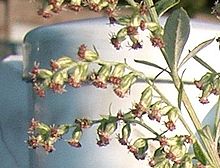Artemisia princeps
| Artemisia princeps | |
|---|---|
 |
|
| Scientific classification | |
| Kingdom: | Plantae |
| (unranked): | Angiosperms |
| (unranked): | Eudicots |
| (unranked): | Asterids |
| Order: | Asterales |
| Family: | Asteraceae |
| Genus: | Artemisia |
| Species: | A. princeps |
| Binomial name | |
|
Artemisia princeps Pamp. |
|
| Synonyms | |
|
|
Artemisia princeps, also called ssuk,Korean wormwood,Korean mugwort, and Japanese mugwort in English, is an Asian plant species in the sunflower family, native to China, Japan, and Korea. It is a perennial, very vigorous plant that grows to 1.2 meters. This species spreads rapidly by means of underground stolons and can become invasive. It bears small, buff colored flowers from July to November which are hermaphroditic, and pollinated by wind. The leaves are feather shaped, scalloped and light green, with white dense fuzz on the underside.
To ancient people in Korea, ssuk was one of the food that was believed to have medicinal or religious value. In the foundation myth of Gojoseon in 2333 BCE, eating nothing but 20 cloves of garlic and a bundle of ssuk for 100 days let a bear be transformed into a woman.
Leaves and young seedlings can be eaten raw or cooked. They can also be used in salads and soups after removal of the bitterness. The young leaves can be lightly boiled before being pounded and added to glutinous rice dumplings known as mochi to which they give a pleasant colour, aroma and flavour.Mugwort mochi can be found in many North American health food stores.
Artemisia princeps is one of the varieties of mugwort used as moxa in Moxibustion, a traditional medical practice of China, Japan, Korea, Mongolia, Tibet, Nepal and Vietnam. An evaluation of the efficacy of the smoke and water extracts of the herb found that both preparations inhibited the growth of a specific line of breast cancer cells in vitro. Phenolics from A. princeps (caffeoylquinic acids (CQA) such as 3-CQA (chlorogenic acid), 4-CQA, 5-CQA (neochlorogenic acid), 1,5-diCQA, 3,4-diCQA, 3,5-diCQA and 4,5-diCQA) alleviated the oxidative stress and enhanced the viability of certain neuronal cells in vitro.
...
Wikipedia
